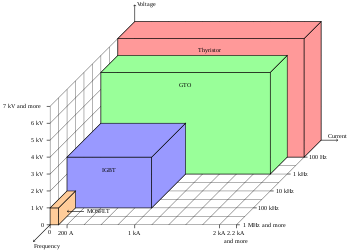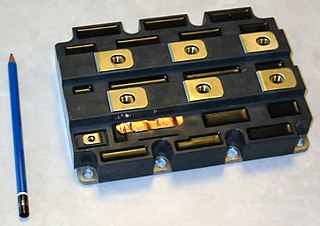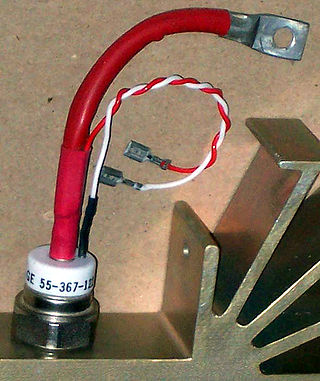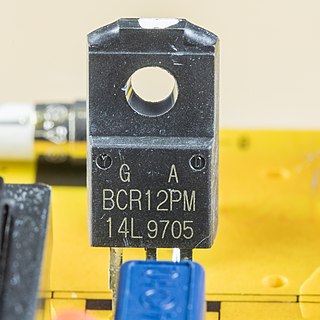Classifications

A power device may be classified as one of the following main categories (see figure 1):
- A two-terminal device (e.g., a diode), whose state is completely dependent on the external power circuit to which it is connected.
- A three-terminal device (e.g., a triode), whose state is dependent on not only its external power circuit, but also the signal on its driving terminal (this terminal is known as the gate or base).
- A four terminal device (e.g. Silicon Controlled Switch -SCS). SCS is a type of thyristor having four layers and four terminals called anode, anode gate, cathode gate and cathode. the terminals are connected to the first, second, third and fourth layer respectively. [17]
Another classification is less obvious, but has a strong influence on device performance:
- A majority carrier device (e.g., a Schottky diode, a MOSFET, etc.); this uses only one type of charge carriers.
- A minority carrier device (e.g., a thyristor, a bipolar transistor, an IGBT, etc.); this uses both majority and minority carriers (i.e., electrons and electron holes).
A majority carrier device is faster, but the charge injection of minority carrier devices allows for better on-state performance.
Diodes
An ideal diode should have the following characteristics:
- When forward-biased, the voltage across the end terminals of the diode should be zero, no matter the current that flows through it (on-state).
- When reverse-biased, the leakage current should be zero, no matter the voltage (off-state).
- The transition (or commutation) between the on-state and the off-state should be instantaneous.
In reality, the design of a diode is a trade-off between performance in on-state, off-state, and commutation. Indeed, the same area of the device must sustain the blocking voltage in the off-state and allow current flow in the on-state; as the requirements for the two states are completely opposite, a diode has to be either optimised for one of them, or time must be allowed to switch from one state to the other (i.e., the commutation speed must be reduced).
These trade-offs are the same for all power devices; for instance, a Schottky diode has excellent switching speed and on-state performance, but a high level of leakage current in the off-state. On the other hand, a PIN diode is commercially available in different commutation speeds (what are called "fast" and "ultrafast" rectifiers), but any increase in speed is necessarily associated with a lower performance in the on-state.
Switches

The trade-offs between voltage, current, and frequency ratings also exist for a switch. In fact, any power semiconductor relies on a PIN diode structure in order to sustain voltage; this can be seen in figure 2. The power MOSFET has the advantages of a majority carrier device, so it can achieve a very high operating frequency, but it cannot be used with high voltages; as it is a physical limit, no improvement is expected in the design of a silicon MOSFET concerning its maximum voltage ratings. However, its excellent performance in low voltage applications make it the device of choice (actually the only choice, currently) for applications with voltages below 200 V. By placing several devices in parallel, it is possible to increase the current rating of a switch. The MOSFET is particularly suited to this configuration, because its positive thermal coefficient of resistance tends to result in a balance of current between the individual devices.
The IGBT is a recent component, so its performance improves regularly as technology evolves. It has already completely replaced the bipolar transistor in power applications; a power module is available in which several IGBT devices are connected in parallel, making it attractive for power levels up to several megawatts, which pushes further the limit at which thyristors and GTOs become the only option. Basically, an IGBT is a bipolar transistor driven by a power MOSFET; it has the advantages of being a minority carrier device (good performance in the on-state, even for high voltage devices), with the high input impedance of a MOSFET (it can be driven on or off with a very low amount of power).
The major limitation of the IGBT for low voltage applications is the high voltage drop it exhibits in the on-state (2-to-4 V). Compared to the MOSFET, the operating frequency of the IGBT is relatively low (usually not higher than 50 kHz), mainly because of a problem during turn-off known as current-tail: The slow decay of the conduction current during turn-off results from a slow recombination of a large number of carriers that flood the thick 'drift' region of the IGBT during conduction. The net result is that the turn-off switching loss of an IGBT is considerably higher than its turn-on loss. Generally, in datasheets, turn-off energy is mentioned as a measured parameter; that number has to be multiplied with the switching frequency of the intended application in order to estimate the turn-off loss.
At very high power levels, a thyristor-based device (e.g., a SCR, a GTO, a MCT, etc.) is still often used. This device can be turned on by a pulse provided by a driving circuit, but cannot be turned off by removing the pulse. A thyristor turns off as soon as no more current flows through it; this happens automatically in an alternating current system on each cycle, or requires a circuit with the means to divert current around the device. Both MCTs and GTOs have been developed to overcome this limitation, and are widely used in power distribution applications.
A few applications of power semiconductors in switch mode include lamp dimmers, switch mode power supplies, induction cookers, automotive ignition systems, and AC and DC electric motor drives of all sizes.
Amplifiers
Amplifiers operate in the active region, where both device current and voltage are non-zero. Consequently power is continually dissipated and its design is dominated by the need to remove excess heat from the semiconductor device. Power amplifier devices can often be recognized by the heat sink used to mount the devices. Multiple types of power semiconductor amplifier device exist, such as the bipolar junction transistor, the vertical MOS field effect transistor, and others. Power levels for individual amplifier devices range up to hundreds of watts, and frequency limits range up to the lower microwave bands. A complete audio power amplifier, with two channels and a power rating on the order of tens of watts, can be put into a small integrated circuit package, needing only a few external passive components to function. Another important application for active-mode amplifiers is in linear regulated power supplies, when an amplifier device is used as a voltage regulator to maintain load voltage at a desired setting. While such a power supply may be less energy efficient than a switched mode power supply, the simplicity of application makes them popular, especially in current ranges up to about one amp.
















